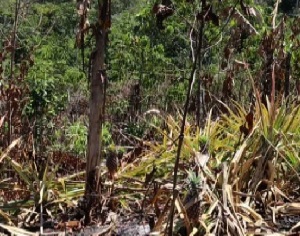by Mickey Kavera – EM TV News, Port Moresby
As the dry season continues to extend due to the El Nino phenomenon, there are rural areas in Papua New Guinea that are greatly feeling the effects.
One such place is the 360,000 hectares of the proposed Managalas Conservation Area located on the Managalas plateau in Afore Local Level Government (LLG), west of Popondetta township in Oro Province.
The last time the area experienced rain was over four months ago, and the drought is making life difficult for the people living on this plateau. According to reports by the 11 Cultural Zone Community Based Organisations (CBOs) which are managed by their local umbrella NGO, the Managalas Conservation Foundation Inc. (MCF), the immediate and major concern for the people has been a shortage of fresh water for cooking, drinking and washing.
This has led to the early closure of several schools on a daily basis at the Afore station, and along the plateau, with students being sent home.
The prolonged drought is already affecting public servants working at Afore station, as well as throughout the Managalas Plateau. With the shortage of water and lack of food a major concern, there are increasing worries regarding health issues as a direct result of the drought.
A national non-government organisation (NGO), Partners with Melanesia Inc. (PWM) has been performing conservation work in partnership with the people of Managalas Plateau through the MCF and the 11 Cultural CBOs.
PWM Program Manager, Rufus Mahuru, said that their concern as an NGO was to help carry out awareness of this plight caused by the El Nino phenomenon, and ensure that the people of Managalas Plateau are well prepared for the likelihood of the dry spell continuing for a prolonged period.
In addition to these concerns, the people of Managalas Plateau are appealing to the Provincial and National Disaster and Emergency Office to assist with relief supplies. Many people have left their villages and have gone into the forest in search of water and food.
“Managalas Plateau in particular is our area of concern as they are our partner in the conservation work that we carry out, and are currently seeking refuge in the area proposed for conservation under the National Protected Area Policy,” Mahuru said.
Project Officer for the Managalas Conservation Foundation (CMF), Dickson Darebo, confirmed that the most affected areas were along the ranges, mainly due to these already being dry and barren prior to the start of the dry spell.
“The Managalas Plateau is divided into two parts, the west and east and areas like Berefo which consists of six villages in Ward 15 of Afore Local Level Government (LLG).
“Oikol tribe in Ward One, Aiari, Suari and Jaure villages along the Sibium Range and the Owen Stanley Range are the worst hit by this drought,” Darebo said.
“Our struggle is real, and it’s very difficult to get by as this drought continues to extend, our people need water to drink and cook, our fresh water creeks are drying up, we need food, our food crops in the gardens are all dying, parts of the ground [are] cracking, showing obvious signs of drought,” Darebo added.
“We need [as much] help [as] we can get from the government, the corporate sector or even aid donors.”
“There are two big rivers that go through the plateau, Bareji and Musa, but the dry spell has seen both river levels drop by at least five meters, even river Pongani has its river bank levels dropping.
Darebo is concerned that the people of Managalas Plateau are only seeing the start of what is to come.
“All creeks and smaller rivers along the plateau are drying up quick, some are all but gone and the people fear the worst is yet to come.”
https://youtube.com/watch?v=7RTyu4dMYMM%3Ffeature%3Doembed%26wmode%3Dopaque%26showinfo%3D0%26showsearch%3D0%26rel%3D0


